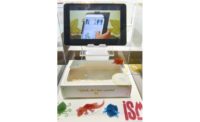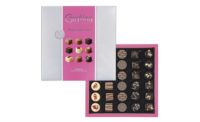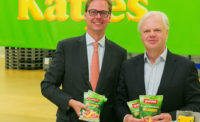What can turn a crusty curmudgeon of an editor into an excitable boy? Well, certainly a visit to the world’s largest confectionery exposition, ISM 2016, which was held in Cologne Jan. 31 – Feb. 3. The 46th annual fair, which drew 38,500 visitors from 146 countries, provided the right environment for such a transformation.
For example, seeing one’s name being etched out by a 3D printer in gummy candy and edible glitter does help turn back the clock.
When Bastian Fassin, managing director of Katjes Fassin GmbH, and Melissa Stover, managing director of Katjes Fassin UK Ltd., provided me with a personal demonstration of the Magic Candy Factory concept, one can’t help but get excited about the technology and “coolness” of it all.
Simply, the Magic Candy Factory can print a gummy candy weighing between 15-25 grams that’s all natural and vegan, gluten- , dairy- and nut-free and ready to consume in just five minutes. Consumers from seven (and younger) to 70 are able to witness the wonders of technological personalization while consuming a confection formulated by an experienced candy maker.
The Katjes booth at the ISM show was overwhelmed with visitors anxious to see the 3D printer whip out names, logos, designs — just about anything conceivable — in 12 different color and flavor combinations, finished off appropriately in either sweet, glitter, sour or fizzy toppings.
A year in development, Fassin and Stover saw an opportunity in the ongoing improvements in 3D printer technology. Fassin, who has a 3D printer at home, recognized the need to ensure a simplified program for such technology to work in a retail environment.
Snover, who founded the Goody Goody Stuff brand in the UK in 2010, eventually selling it to Cloetta last year, realized that the future of the food industry lies in integrating health and wellness, natural ingredients and lifestyle with new technologies.
The two then collaborated to develop a system that simplifies 3D printing technology and integrates it with Katjes’ formulation expertise to deliver excitement, innovation and personalization at the retail level.
As Fassin explains, “This is not a marketing campaign; it’s a business model. We’ve optimized the process.”
Conventionally produced gummy candy normally takes up to 72 hours to cool, he adds. The combination of Katjes’ ingredients along with Magic Candy Factory process allows customers to make and eat their personalized candy in under 10 minutes.
All candy is produced from a set of premixed, clean and FDA & FSA (UK Food Standards Agency) approved ingredients, which are put into a cartridge and then placed into a 3D printer where they are heated and extruded to create a beautiful shape in a specific color/flavor/shape/finish.
Trained operators can, with the help of the Internet, transpose designs for the customer. This also opens up another avenue for retailers, says Snover.
“When the shop’s closed in the evening, the retailer can be working on wholesale corporate accounts,” she explains.
Currently, the Magic Candy Factory is in negotiations with retailers in Europe and the United States to introduce the concept into stores. And by the way, the Magic Candy Factory’s 3D Printer took first place in ISM’s Innovation Awards. No surprise really.
As for other surprises at the show, well, yes and yes.
James Walker from Walkers Shortbread Ltd. winning ISM’s Achievement Award proved to be a pleasant surprise. Following in the footsteps of previous winners, Herm Rowland of Jelly Belly Candy Co. and Felix Richterich of Ricola AG, Walker was recognized for “exceptional services to the sweets and snacks industry.”
Oscar Kambly, owner of Kambly Ltd., the renowed premium Swiss biscuit manufacturer, provided a stirring introduction for Walker at the ISM dinner, which was held Sunday evening, Jan. 31.
The four-time Queen’s Award winner, who exports his line of biscuits to more than 100 countries, embodies the very best characteristics of entreneurship, combining integrity with brand building, Kamby said.
“Walker has a respect for life, respect for the gifts of nature,” he emphasized. “In his case, leading means serving.”
Noting that Walker has used only the “very best ingredients and recipes,” Kambly reaffirmed that the managing director’s major ingredient was “integrity, which he lived daily.”
Another surprise I discovered at the show was a willingness by companies — be they large or small — to be a bit more adventuresome in their new product launches. Take for example, Guylian, the famed Belgian chocolate manufacturer of seahorse-shaped pralines.
When was the last time that a company such as Guylian opted to introduce a matcha tea filling into their chocolate praline lineup? This year, they did.
As the company explains, “These new Sea Horses are a sweet wedding between a Belgian and Asian specialty, a perfect pairing of the sweetness of white chocolate and the pure taste of Matcha green tea. Matcha green tea is the most premium and one of the oldest varieties of green tea in Japan. It’s highly treasured and known for its many health benefits as well as inducing a meditative state of mind, following an ancestral tea ceremony.”
In retrospect, it’s not that unusual that there’s a bit of East-West fusion given Guylian’s parent, Lotte Confectionary, Ltd., is from Japan. Not sure whether there was any East-West fusion or not in Guylian’s upcoming seasonal item, Belgian Chocolate Waffles, but it certainly represents a winning example of creative, chocolate making.
Twelve waffle cones filled with chocolate cream and topped with a white sugar glaze provided an “out of the box” experience for customers looking for the perfect host/hostess gift during the fall/winter holiday season.
Guylian also is introducing a line of chocolate-covered blueberries, raisins and cranberries this season, to provide consumers a healthy option that features Belgian chocolate.
Gregory Rosendahl, newly appointed president of Guylian US, points out that consumers love Belgian chocolate and that the company looks to take advantage of that affinity by offering customers the broadest range of gifting and self-consumption items possible.
Another company that’s taken a more adventuresome route in new product development is ICAM. The Lecco, Italy-based company is launching a line of pralines in four non-traditional flavor varieties: black cherry and black pepper; tangerine and ginger; pink grapefruit and blueberry.
All of the centers have been formulated with Italian extra virgin olive oil instead of palm oil to give the centers a unique creamy softness while further accenting the Italian connection. The new Vanini Le Praline Gourmet line will debut this summer and come in three package sizes: slim case (eight pieces), top case (16 pieces) and gift box (20 pieces).
The company, which is celebrating its 70th anniversary this year, has also been creative with the introduction of new varieties in its bar line that features Bagua cocoa from the Amazon. The two new flavors are lemon and pink pepper as well as pear and cinnamon. Definitely breaking new ground here.
Speaking of breaking new ground, Barry Callebaut was touting its thermo-tolerant Choc37.9 as a solution for the increased demand for chocolate and compound products in warmer climates. “Our new Choc37.9 offers great potential for tasty chocolate experiences in warmer climates,” says Bas Smit, Barry Callebaut’s head of global and European marketing. “Products can be displayed in stores, there is no need any more for cooled transportation in certain areas and the whole logistic process in general is simplified enormously.”
The need to develop heat-resistant chocolate became very visible at the World Expo in Shanghai in 2010, where customers of the Chocolate Corner in the Belgian pavilion saw their chocolate turn into mush upon returning home in the South China heat.
“I thought if we want to bring chocolate to countries like China or India, we needed to change something,” said Frederic Depypere, who contributed together with Project Lead Elien Van Steen to the development of this game-changing chocolate. After four years of intensive research, Barry Callebaut perfected a melting profile that peaks up to 4° higher than normal chocolate.
The world’s largest purveyor and processor of chocolate also unveiled its Caramel Doré product, which offers consumers a warm and creamy caramel touch to their premium chocolate experiences
“We are constantly innovating to create products that trigger the imagination of consumers,” says Smit. “The Caramel Doré, with its unique flavor and texture, offers a new taste sensation, based on one of the most popular flavors in the chocolate world.”
But continuing on the chocolate side, and adding a “French touch” to its offering, CEMOI unveiled a lineup touting higher cocoa percentage for its CEMOI and Jacquot brands. Along with its classic milk chocolate, 72% and 85% dark chocolate bars, the company added two original varieties featuring speculoos biscuits and pistachio pieces inclusions.
Under the Jacquot brand, CÉMOI Group offers a range of finely produced chocolate bars with high cocoa content. Its 100g bars are perfect for dark chocolate aficionados, who appreciate 70% cocoa, 80% cocoa and 64% cocoa with cocoa nibs offerings.
That classic “French touch” continues with the company’s new truffles offerings, which are inspired by traditional French pastry recipes. These fruity and crispy truffles come in Raspberry Crumble, Lemon Meringue and Flaky Pear Pastry dessert flavors.
And CÉMOI’s Les Pearls are sweets that are uniquely filled with an array of exotic ingredients, such as pecan pie, licorice raspberry, pineapple and coconut and crispy truffle.
Before I depart from chocolate and discuss some sugar manufacturers I visited, I needed to mention two companies from South Tyrol: Loacker and Oberholler. I know most of you are familiar with Loacker, the famed manufacturer of premium wafer-based confections.
My annual visit with Ulrich Zuenelli, chairman of Loacker, typically takes place during lunch over a glass of Loacker wine (of course!), some speck (a South Tyrolian air-cured aged ham) and cheese. This year was no exception.
What was an exception were Loacker’s volume gains, something that Zuenelli said he “wouldn’t have dared to plan for.”
“It was the single biggest volume growth in our corporate history,” he explained. “We grew by 3,700 metric tons, mostly driven by international sales that increased by 23 percent.”
International sales now account for nearly 70 percent of the company’s revenues. Known for its broad range of high-end wafer products, Zuenelli said that last year represented a “big step” for the company in expanding its portfolio of wafer-based chocolate specialty items.
This year the company looks to take advantage of the increasing popularity of white chocolate, especially Loacker’s white chocolate which contains a high percentage of cocoa butter and less sugar, as well as the continued growth and interest in dark chocolate.
The range of new products includes white chocolate-enrobed wafers, Cocoa & Milk wafers, that is dark chocolate wafers with a white cream filling, as well as hazelnut-filled combinations in both dark and white chocolate offerings.
Separately, the company looks forward to beginning production at its new plant in Heinfels, Austria this spring. The 36,000-sq.-meter, three-story facility will kick off with two large automated wafer lines, a chocolate enrobing line and three packaging lines. Essentially, the new facility will double tonnage for Loacker, addressing the volume growth attained last year.
Loacker has also begun to implement a vertical integration strategy, one that involves the planting of hazelnut trees on 50 hectares. The plan calls for acreage to increase to 112 hectares. The company also looks to pursue ownership of additional farm lands for other ingredient needs.
Interestingly, vertical integration has always been part of Oberholler’s operation. This small, family-owned gourmet chocolatier located in Sarentino, Italy, has quietly but passionately produced a broad range of chocolate bars with select inclusions and hazelnut spreads in the basement of Paula and Toni Oberholler’s home for decades.
At ISM Obernoller unveiled a new line of Chocolate Flakes, essentially very thin squares containing an equally thin layer of filling that’s the epitome of chocolate indulgence. The alcohol-filled fillings, which include whiskey, rum, raspberry grappa and hazelnut liquor, are all sourced from the Southern Tyrolian region. Trust me, you don’t want to be a teetotaler with these exquisite chocolates.
Before moving over to sugar, I’d be remiss in not mentioning Nugali, that pioneering bean-to-bar company from Brazil. They continue to experience double-digit annual growth, 30 percent last year, as consumers around the world rediscover the nuances of Bahian fine-flavored cocoa beans.
The company recently redesigned its packaging and introduced a chocolate-covered banana dragee. Its new Nuances assortment provides consumers with 40 mini tablets of four popular varieties: 80% amargo chocolate, 70% amargo chocolate, milk chocolate and 70% cacao au flor chocolate.
The company looks to build a new 2,500-sq.-meter plant by 2017, says Ivan Blumenschein, the company’s production manager. Thanks to Nugali and other bean-to-bar chocolatiers in Brazil, consumers are being to take notice that Brazilian cacao can provide a gourmet experience.
And that’s a sweet thing.
Speaking of sweet, a stroll to Fini’s booth revealed a vast array of gummies, licorice and marshmallows. One of the interesting new launches comes on the marshmallow side. Looking for a way to energize the category, Fini’s R&D department came out with a “crunchy” marshmallow.
As Manolo Nicolas explained, “there’s nothing like this on the market.” Available in strawberry, rainbow and “Diablo” flavors, the lineup adds some texture to that squishable tactile experience.
The company also unveiled its 3D bears gummies line, Kollisions, a mix of sweet and sour licorice, and Revolvers, a two-in-one soft and chewy licorice shaped like the chamber of a revolver.
Anyone looking for creative shapes — as well as a fine lunch of Nurnberger sausages, German potato salad and sauerkraut — knows to stop by the Trolli booth. This year, Herbert Mederer, the creative genius behind every Trolli new product, took note of the zombie craze in the media and came out with a Trolli Super Brain.
Shaped like a real brain, the sugar foam candy delivers a tangy fruit juice filling of strawberry, mango and orange. Give me brains!
Children, and adults, seeking another taste experience needed only to bite into Dino Rex, which provides a sour experience on the outside with an intense fruit sensation on the inside that smacks of strawberry and raspberry, lemon and orange and lime and kumquat flavors.
One of the most interesting offerings involves jewelry, gummi bracelets and necklaces. Using a patent-pended process, Mederer devised a way to create edible gummi bling. The Trolli Gum Pearls look to be another winner for the company.
Looking to win a larger audience in the United States is Peccin. The Brazilian company’s new Acai candy line features the superfruit integrated into banana, guaranja and strawberry formulations. Touting its high content of vitamins A, C, E, B1, B6 and K1, the company looks to attract parents searching for all natural and healthy sweets that they give to their children. This definitely answers the call.
Believe me, there was so much more at ISM. But the space and time continuum prevent me from going on. Apologies to all that I didn’t get to or highlight. Visit www.ism-cologne.com for the complete breakdown of trends and new products.























